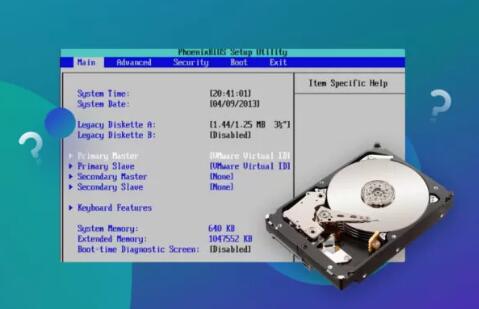Disk failure is one of the most feared problems for anyone who stores data on a computer or external device. When a hard drive or solid-state drive (SSD) fails, it can result in the loss of critical files, photos, documents, business data, or memories. However, depending on the type of failure and the steps taken afterward, data recovery may still be possible.
Disk failure refers to the situation where a hard drive or SSD stops functioning correctly and cannot reliably read or write data. This may be due to mechanical, electronic, firmware, or logical problems that prevent the drive from operating as intended.
Disk failures can be broadly categorized into two types:
Logical Failure: The drive hardware is intact, but the file system, partition table, or data is corrupted or deleted.

Physical Failure: The actual hardware components inside the drive are damaged, such as read/write heads, platters, motors, or circuit boards.
Types of Disk Drives Affected
Hard Disk Drives (HDDs): These use spinning magnetic platters and mechanical arms for reading/writing data. They are more prone to mechanical failures.
Solid State Drives (SSDs): Use flash memory with no moving parts. Failures usually involve electronic, firmware, or data corruption issues rather than mechanical damage.
Common Causes of Disk Failure
1. Mechanical Failure (HDD-specific)
Head crash: The read/write head touches the disk platter, causing scratches.
Motor failure: The spindle motor fails, so platters don’t spin.
Actuator failure: The arm controlling the heads malfunctions.
Bearing failure or worn-out parts from aging.
2. Electronic Failure
PCB (Printed Circuit Board) failure due to power surges or electrical faults.
Corrupted drive firmware that prevents proper operation.
3. Logical Failure
File system corruption due to improper shutdowns, viruses, or software errors.
Accidental deletion or formatting of partitions.
Bad sectors or corrupted partition tables.
4. Environmental Causes
Physical shocks or drops.
Exposure to water or extreme temperatures.
Power surges or outages during operation.
Signs of Disk Failure
Recognizing early warning signs can help save your data by acting before total failure:
Unusual noises such as clicking, grinding, or buzzing from the drive.
System crashes, freezes, or blue screens during disk access.
Files suddenly disappearing or becoming inaccessible.
Drive not recognized by BIOS or operating system.
Slow read/write speeds and frequent I/O errors.
Drive showing as RAW or unformatted.
Frequent error messages when opening or saving files.
Diagnosing Disk Failure
Step 1: Verify Connections
Before assuming failure, check cables, ports, and power supply.
Step 2: Check with Disk Management Tools
Use operating system utilities like:
Windows: Disk Management, CHKDSK
Mac: Disk Utility
Linux: fdisk, smartctl
These tools show the drive status, partitions, and SMART health data.
Step 3: Use Diagnostic Software
Run manufacturer tools (like SeaTools for Seagate, WD Data Lifeguard) or third-party tools like CrystalDiskInfo to assess drive health.
Data Recovery Approaches
Logical Failure Recovery (DIY Methods)
If the disk is physically healthy, you can try software recovery:
Use Data Recovery Software: Programs like Recuva, EaseUS Data Recovery, Stellar Data Recovery, R-Studio, and Disk Drill can scan and recover deleted files or lost partitions.
Repair File System Errors: Run CHKDSK or Disk Utility First Aid.
Clone the Drive: Use software like Clonezilla or Macrium Reflect to create an image of the failing drive to work on safely.
Physical Failure Recovery
Physical failures require professional intervention:
Do Not Power On Repeatedly: Further operation may worsen damage.
Professional Cleanroom Repair: Specialized labs open the drive in a cleanroom to replace damaged parts.
Firmware Repair or Recovery: Experts fix corrupted firmware or PCB issues.
Data Extraction: Using proprietary tools to retrieve data from platters.
Step-by-Step DIY Data Recovery for Logical Failures
Stop Using the Drive: Avoid overwriting lost data.
Connect Drive to a Stable Computer: Use a reliable USB adapter or SATA connection.
Run Diagnostic Software: Check SMART status and perform a surface scan.
Create a Disk Image: Backup the entire drive to avoid working on the failing device.
Run Recovery Software: Scan the image or the drive for recoverable files.
Recover Files to a Different Drive: Never recover to the same failing drive.
Backup Recovered Data Immediately.
Professional Data Recovery Services
When to Seek Professionals?
Drive is making unusual noises.
Drive not detected at all.
Firmware corruption suspected.
Physical or water damage.
Previous DIY recovery attempts failed.
Data is extremely critical or irreplaceable.
What Professionals Do
Open the drive in a cleanroom environment.
Replace defective parts like heads or PCBs.
Use advanced tools to repair firmware.
Extract data using specialized hardware and software.
Recover RAID or SSD data with complex techniques.
Cost of Disk Failure Data Recovery
Recovery cost depends on the complexity:
Logical recovery: $100–$600
Physical recovery: $800–$2.500+
Firmware recovery: Can increase costs due to complexity.
RAID or SSD recovery: Often $1.500–$5.000+
Many companies offer free diagnostics and “no data, no fee” policies.
Prevention of Disk Failure
Regular backups to cloud or external drives.
Use surge protectors and UPS.
Handle drives carefully, avoid physical shocks.
Monitor drive health with SMART utilities.
Keep drives cool and avoid extreme temperatures.
Use antivirus and keep software up to date.
Properly eject external drives before disconnecting.
Disk failure can be devastating, but understanding the types, symptoms, and recovery methods increases your chances of saving your data. Always act quickly but carefully, and know when to trust professionals. Prevention through backup and proper handling remains the best defense.
About us and this blog
Panda Assistant is built on the latest data recovery algorithms, ensuring that no file is too damaged, too lost, or too corrupted to be recovered.
Request a free quote
We believe that data recovery shouldn’t be a daunting task. That’s why we’ve designed Panda Assistant to be as easy to use as it is powerful. With a few clicks, you can initiate a scan, preview recoverable files, and restore your data all within a matter of minutes.

 Try lt Free
Try lt Free Recovery success rate of up to
Recovery success rate of up to









